The concentration camp at Majdanek was one of the largest Nazi death camps of them all, and visiting Majdanek will leave just as big an impression on you. Much of the original camp still stands which makes it one of the most effective testaments to Nazi atrocities. You must see it with your own eyes.
This quick guide will tell you everything you need to know in order to visit the former Majdanek concentration and death camp for yourself.
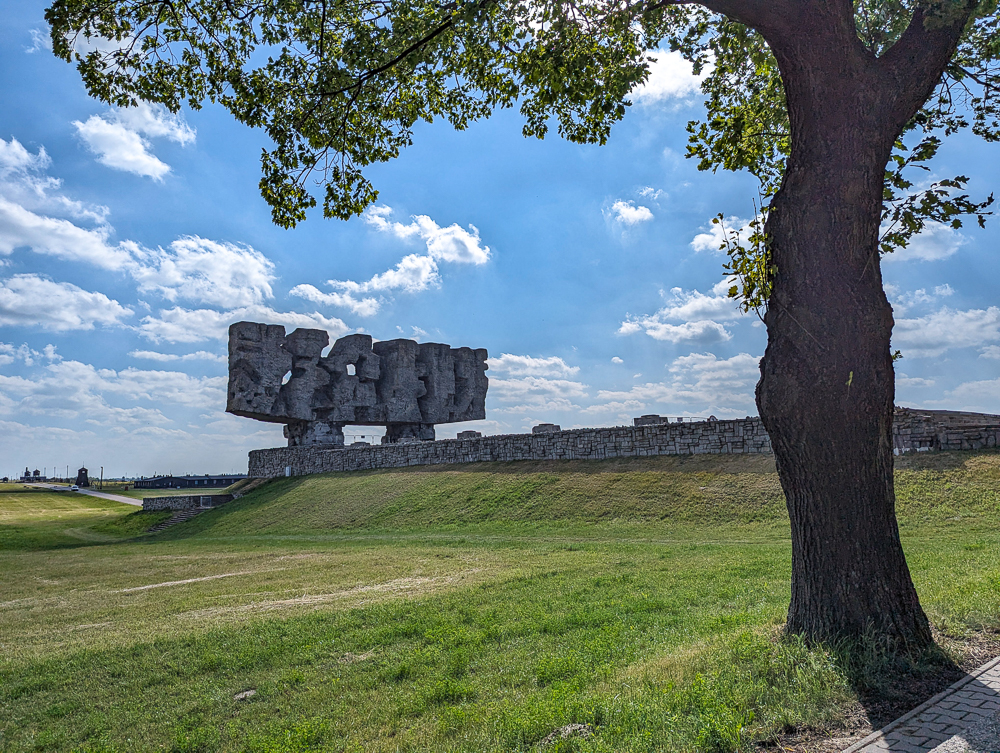
What is Majdanek?
Along with Auschwitz, Belzec, Chełmno, Sobibór, and Treblinka, Majdanek was one of the six major Nazi death camps during the Holocaust. It operated from October 1941 until July 1944 when the SS hastily abandoned it as Soviet troops closed in.
Initially, Heinrich Himmler ordered the construction of Majdanek as a concentration/forced labor camp for an ever-increasing number of Soviet POWs and other prisoners. However, with the launch of Operation Reinhard, Majdanek became an increasingly useful cog in the Nazi’s “final solution to the Jewish question” as a deadly forced labor headquarters.
Majdanek concentration camp is also often referred to as KL-Lublin which stands for Konzentrationslager Lublin (“concentration camp Lublin”).
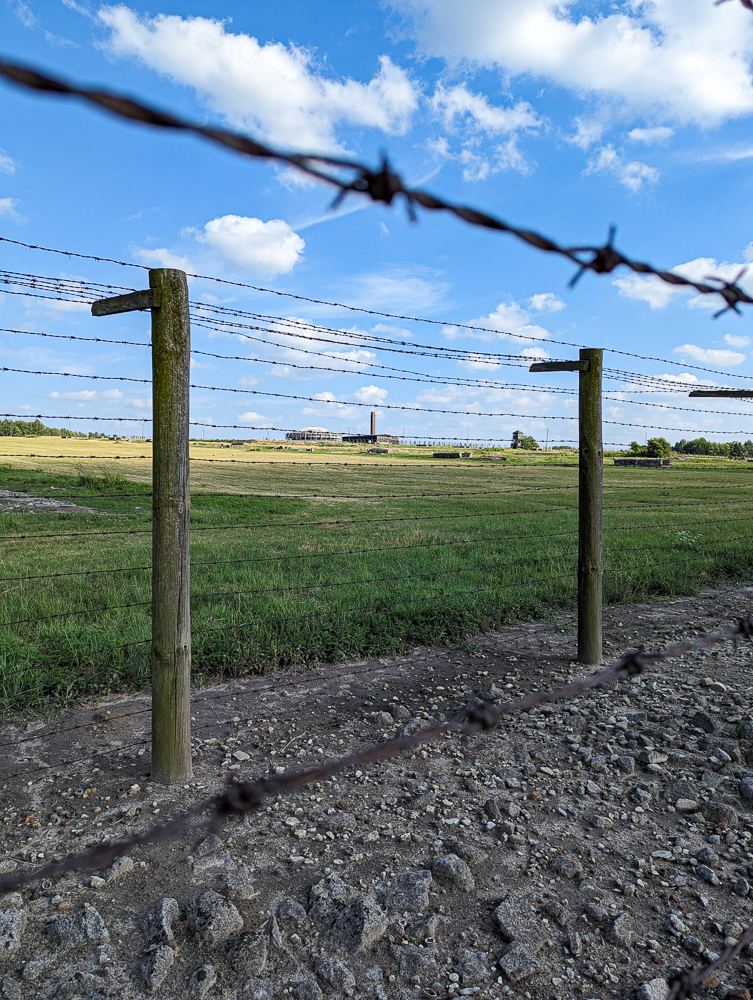
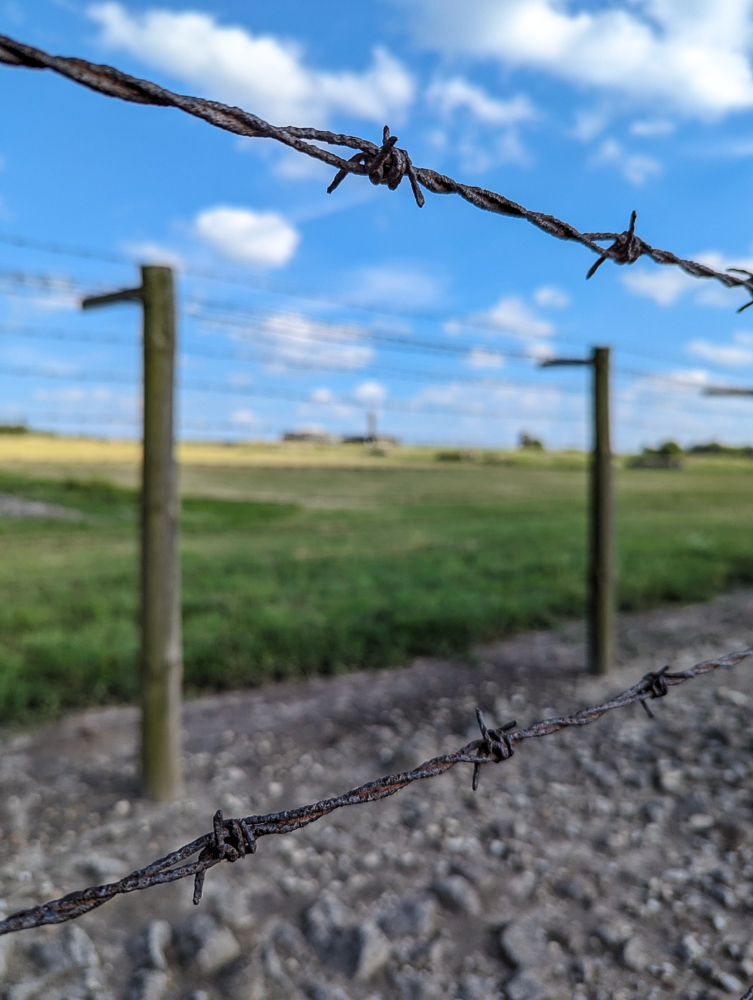
Jews on the way to their deaths at other camps around Poland (and even the Czech camp Theresienstadt), who appeared suitable for work, were regularly plucked from their trains and sent to Majdanek. Some whole transports on their way to killing centers diverted to Majdanek for forced labor instead. And when the SS liquidated the Warsaw ghetto in 1943, they sent those tens of thousands of Jews to work in Majdanek as well.
These laborers were to be put to use in a variety of industries, all of which contributed to Nazi Germany’s eastward expansion. But the constantly growing number of prisoners meant serious overcrowding. And overcrowding meant certain death for those forced to live in unlivable conditions. Starvation, cold, disease, torturous physical labor, severe punishments, and outright murder claimed the lives of approximately 78,000 prisoners in Majdanek’s less than three years of operation.
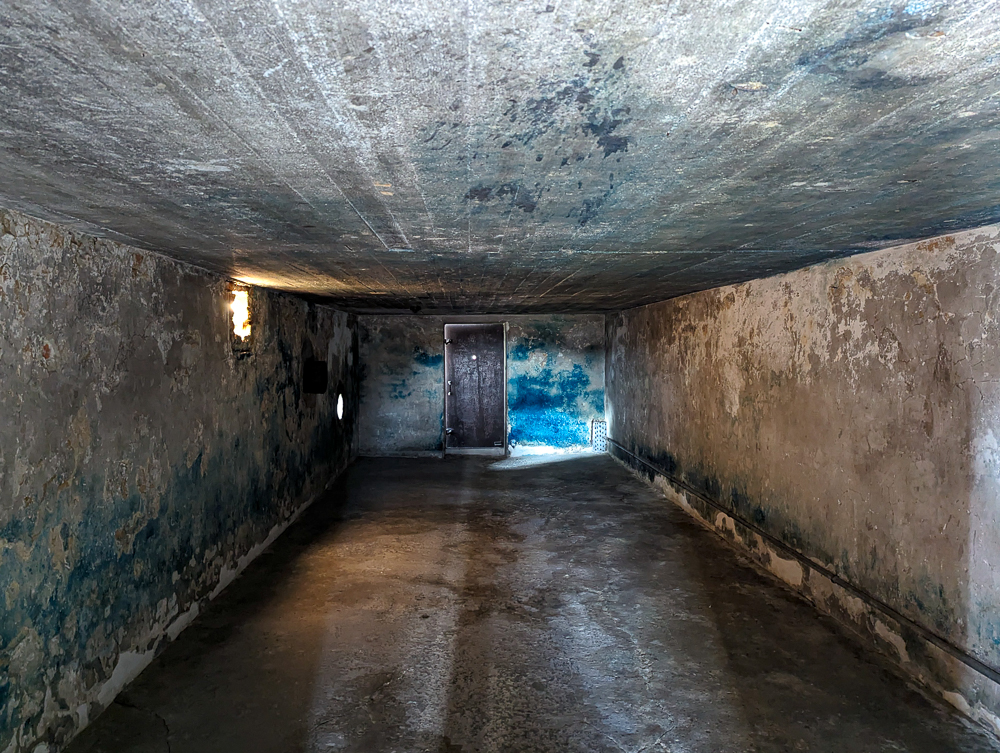
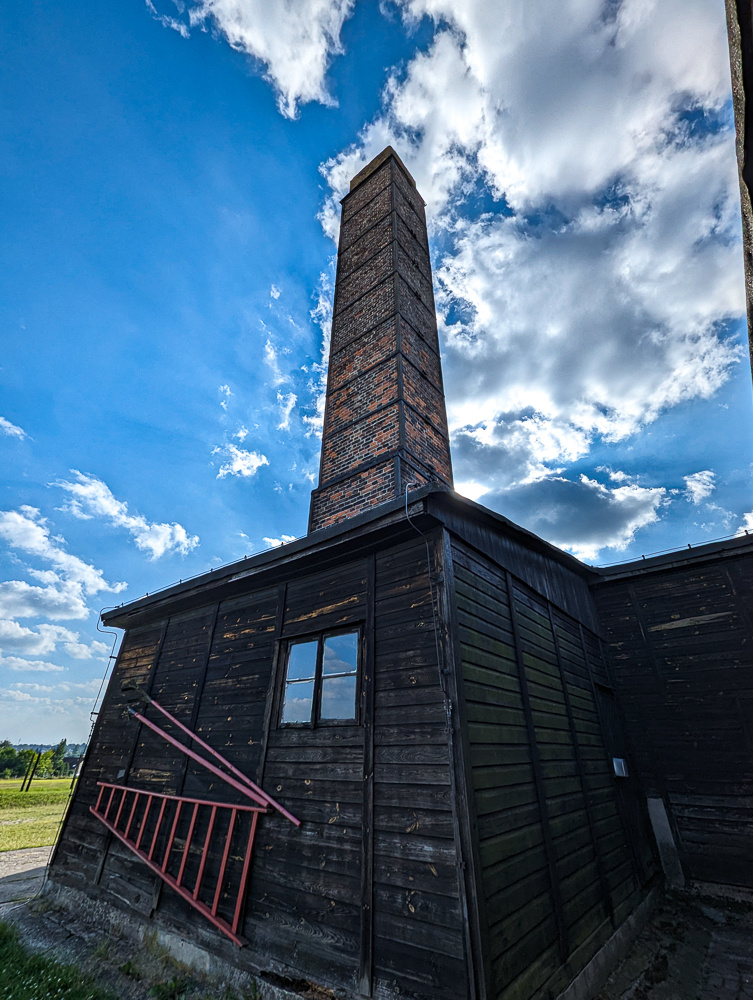
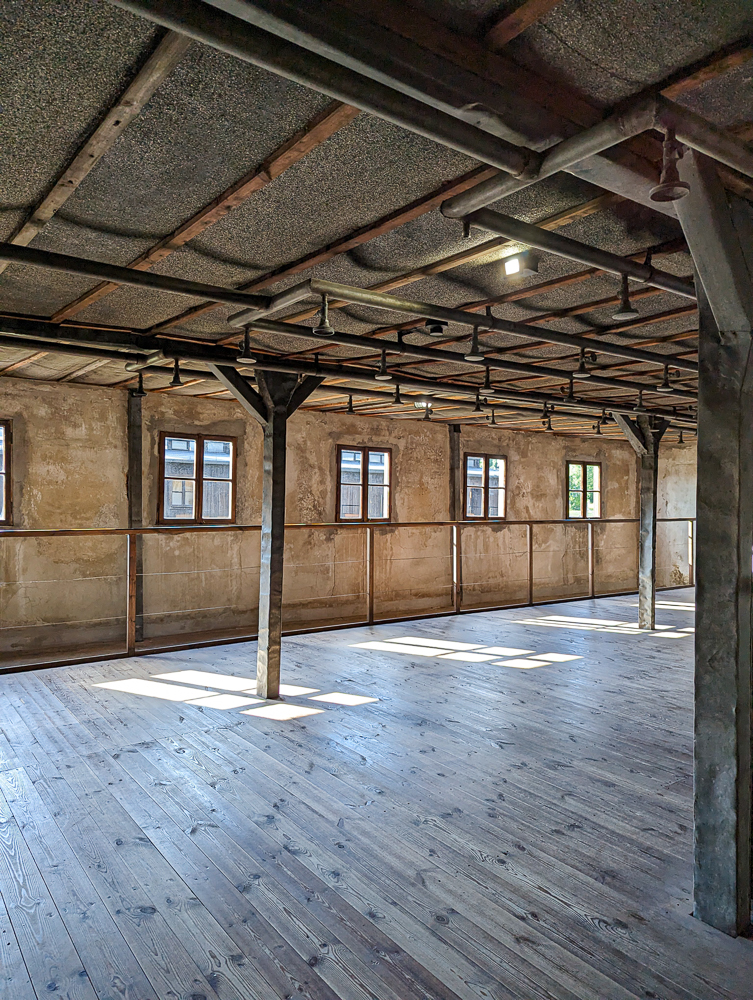
Majdanek as a killing center
Unlike places like Auschwitz and Chełmno for example, Majdanek didn’t serve as a dedicated murder factory. All that means is that Majdanek’s prisoners were murdered with less efficiency. Being a labor camp, when prisoners became too weak or ill to work, they were executed. Most were shot, many were beaten to death, and still others were gassed. Beyond that, just as many more were killed through intentional or systematic starvation, exhaustion, and medical neglect.
More efficient killing began at Majdanek in October 1942 with the introduction of Zyklon B. Majdanek had three functioning gas chambers—two of which used Zyklon B, and a third that used carbon monoxide like those at Belzec.
Early on, the victims’ bodies were buried in mass graves. As numbers grew, they were later burned in either the camp crematorium or on pyres out in the open. Their ashes would be mixed with soil and used around the camp as fertilizer. (Knowing this makes seeing the beautiful flowers outside the crematorium today all the more chilling.)
In Frankfurt, Germany you can see the Holocaust memorials at the former headquarters for IG Farben–manufacturer of Zyklon B.
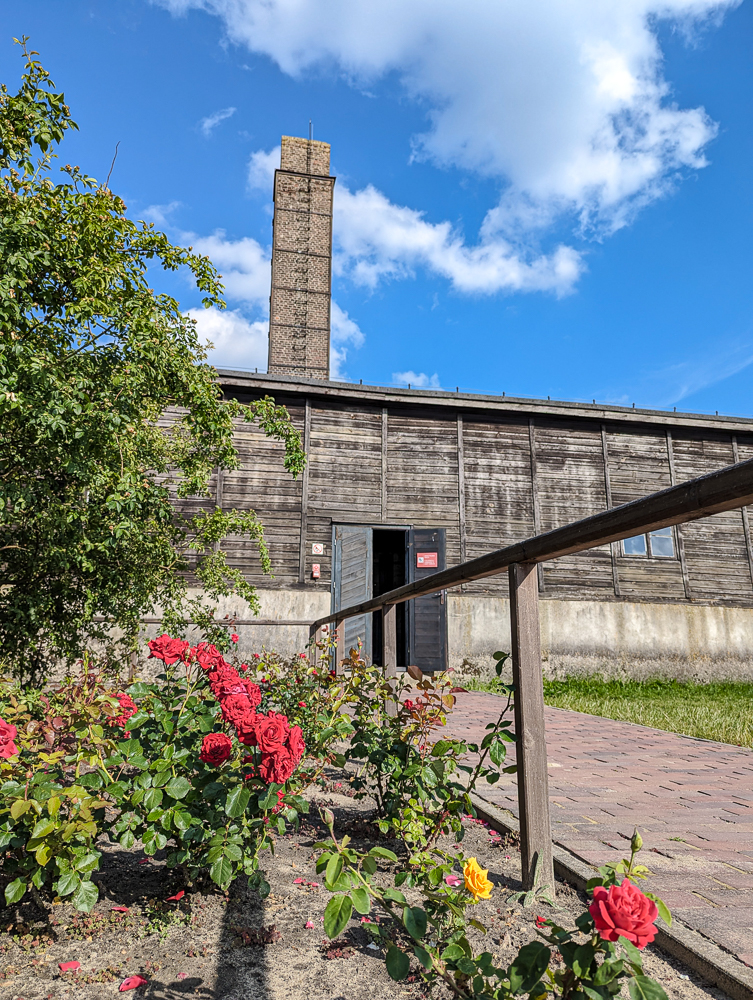
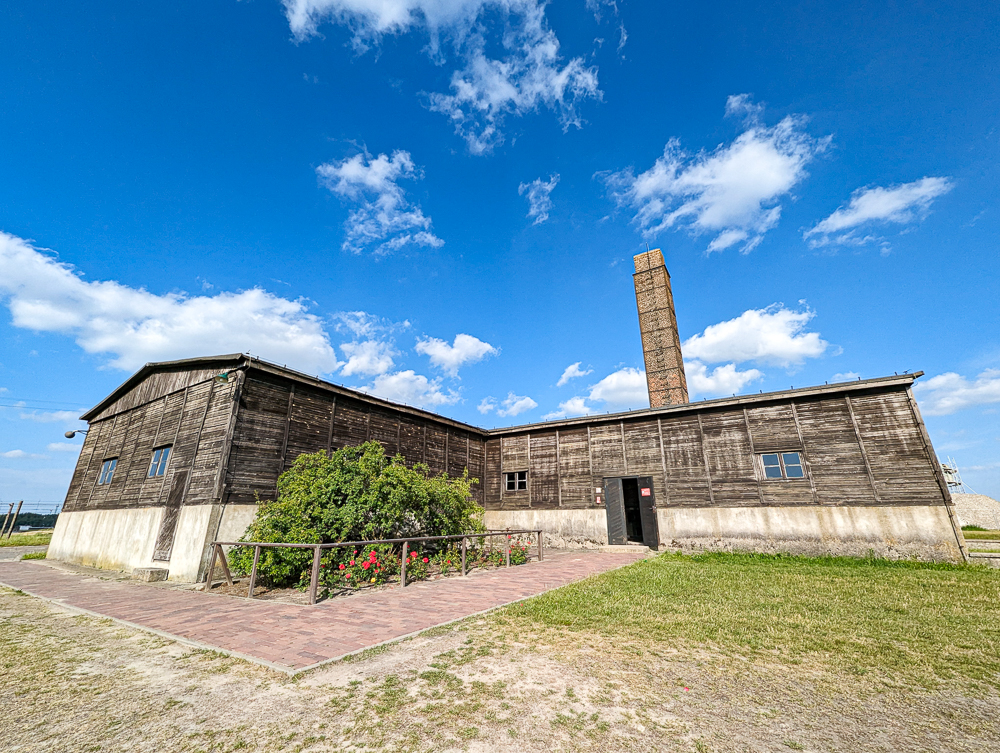
Majdanek liquidation and liberation
As Allied forces closed in towards the end of the war, the Nazi regime tried desperately to hide evidence of its mass atrocities. This included evacuating prisoners from their camps, blowing up buildings, and destroying documents.
In Majdanek’s case, with the tide of war against the Soviet Union turning against them, the SS began evacuating its prisoners to camps further west in early 1944. As the Red Army closed in on Lublin a few months later, the SS fled the camp in such a hurry that they weren’t able to destroy it on the way out. When Soviet forces liberated Majdanek on the night of July 22-23, 1944, they found the camp’s infrastructure pretty much completely intact. The amount of damning evidence was staggering.
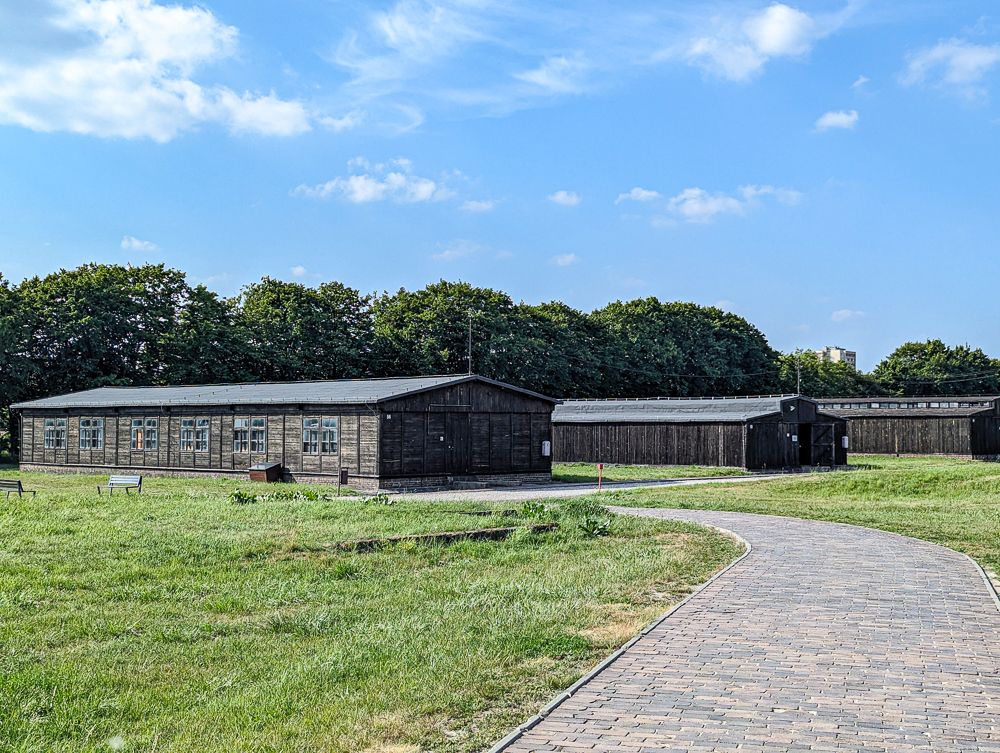
Majdanek today
Majdanek was the first major Nazi concentration camp to be liberated and was thereby humanity’s first exposure to such horrors. Almost immediately, the camp was preserved as an important historical and memorial site. The Majdanek State Museum was founded in November 1944, making it the oldest of all the concentration camp memorial sites.
Visiting Majdanek today, you’ll be able to see and tour many of the original prisoner barracks and other structures like the crematorium, the gas chambers, and more. You can see several monuments and memorials, explore the museum exhibitions, and walk all throughout the grounds of this former camp.
Another thing you’ll notice about visiting Majdanek today is how central it is. Many camps, like Sobibór and Treblinka for example, are pretty remote. But Majdanek is smack in the middle of a developed area on the edge of a larger city, on a main road. I remember thinking as I pulled up to the site, “There’s no way we’re already here; this is in the middle of a city!”
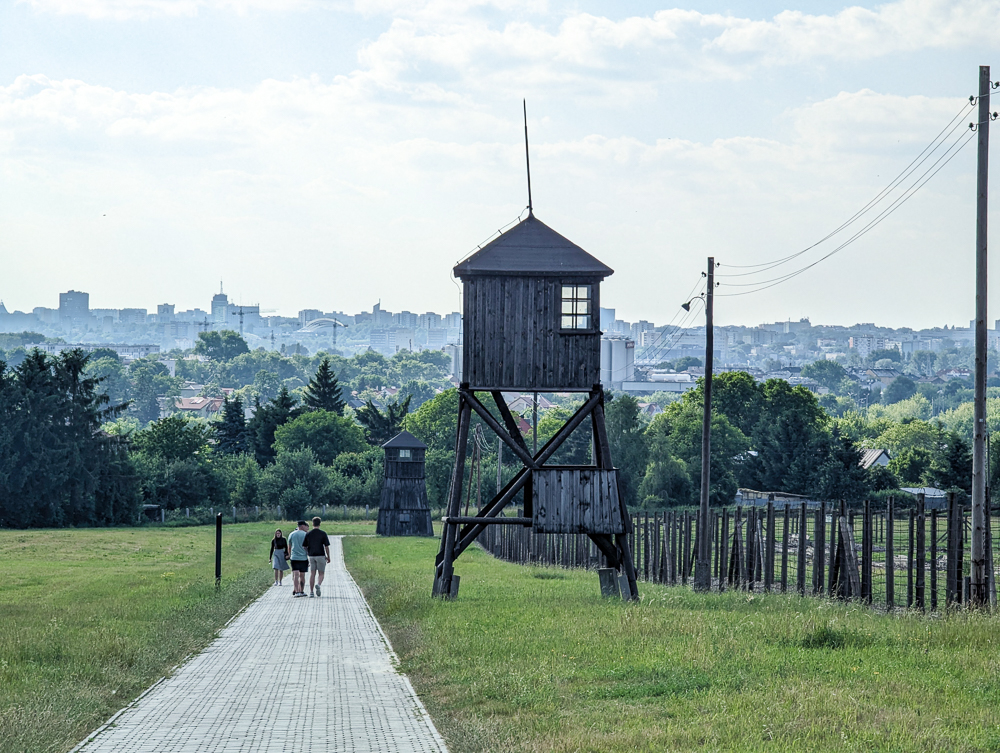
Why visit Majdanek?
The reason anyone would want to visit a Nazi concentration camp is likely very personal. But one reason everyone should is to bear witness. The Nazi regime did its very best to rid the world of these people and then did everything it could to cover that up. Their memories and what happened here could easily have vanished from history.
I feel we owe it to the victims to learn about their experiences and the horrors they endured here. And, to stick it to those who thought they could get away with it. There will never be a befitting punishment for these heinous crimes, but it’s important to say We see you and we know what you did. If for no other reason, visit Majdanek so that what happened here won’t be forgotten and thus never repeated.
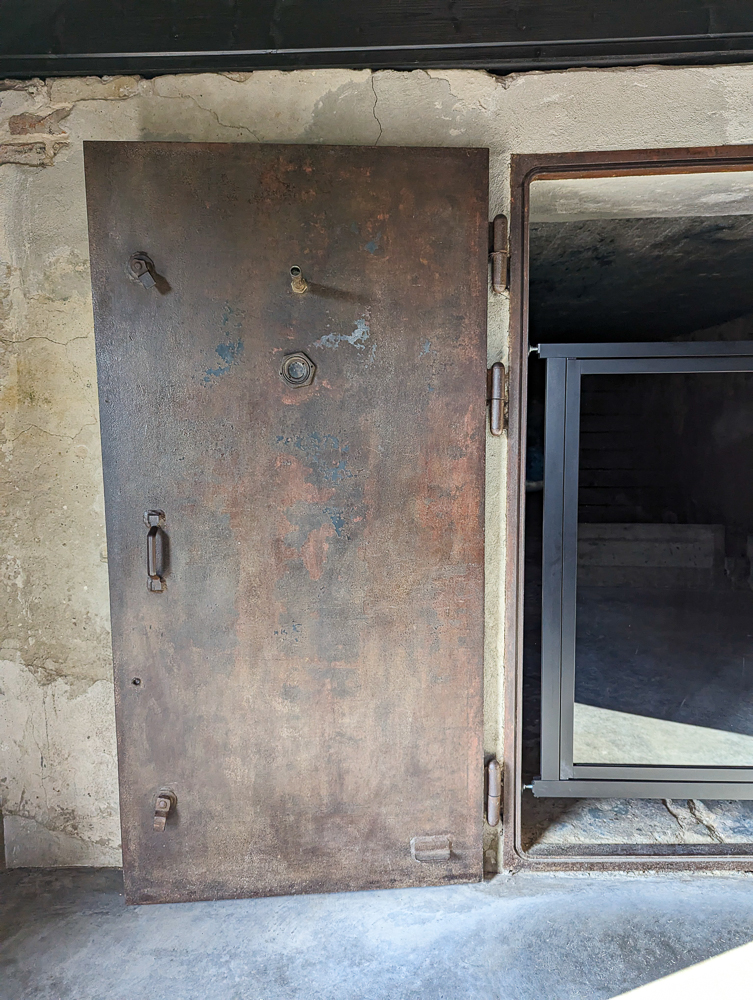
Where is Majdanek concentration camp?
Majdanek concentration camp is located just outside the city of Lublin to the southeast.
How to get to Majdanek
Given its location next to a major city, there are several ways you can get to the former camp site at Majdanek. The easiest way is by car. (Rent a car here if you need to.) The Majdanek camp and museum is a:
Once here, you’ll find a dedicated parking area to the left of the main building, just off the main road. Parking costs 10PLN per car (about $2.50US).
GPS address: Droga Męczenników Majdanka 67, 20-325 Lublin, Poland
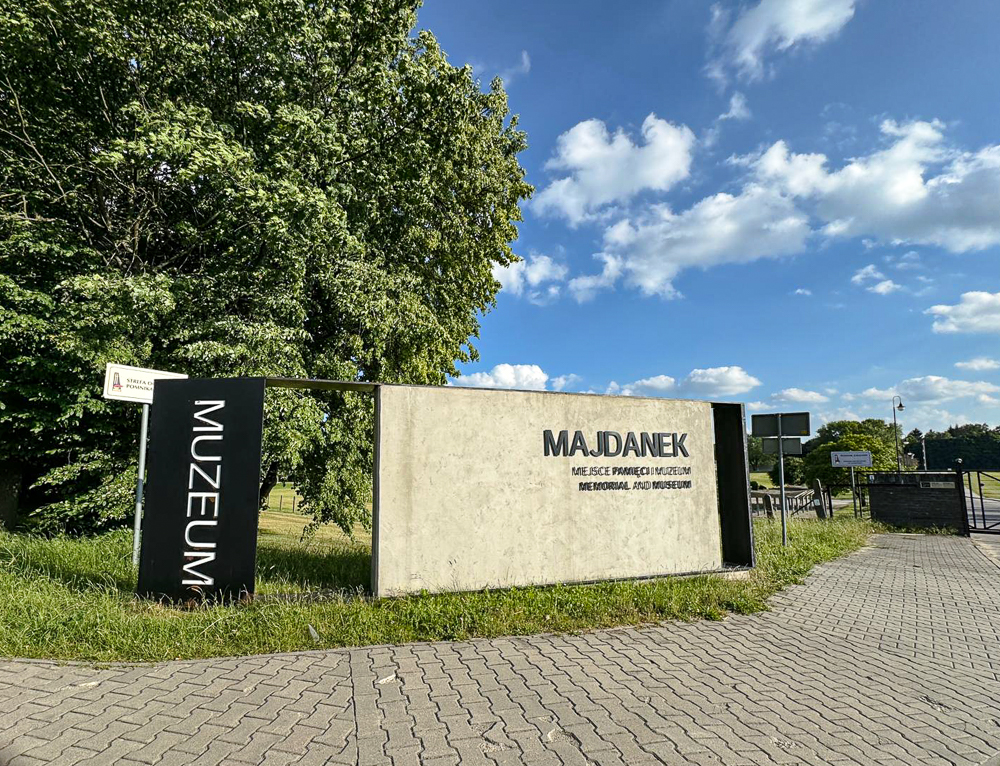
Also read: Driving in Poland: What You Need to Know Before You Hit the Road
By train or bus
You can get to Lublin Główny (central train station) from just about anywhere in Poland—see schedules and routes here.
From here, you can get to the Majdanek site using Lublin bus lines 21, 23, 35, or 47. There are two stops in this area–Majdanek 01 (the closest to the main visitor center entrance) and Majdanek-Monument NZ 01. See bus info here.
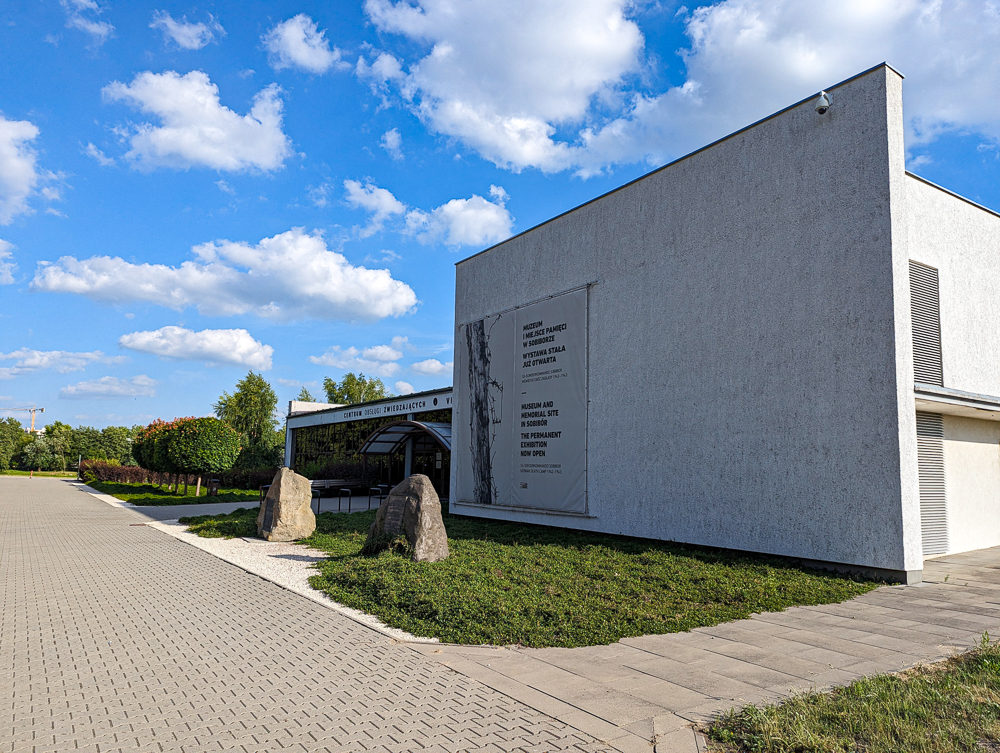
By organized tour
It’s also possible to visit Majdanek on an organized day tour from either Warsaw or Lublin. Here are a few examples:
See my full 2-week Poland WWII itinerary here.
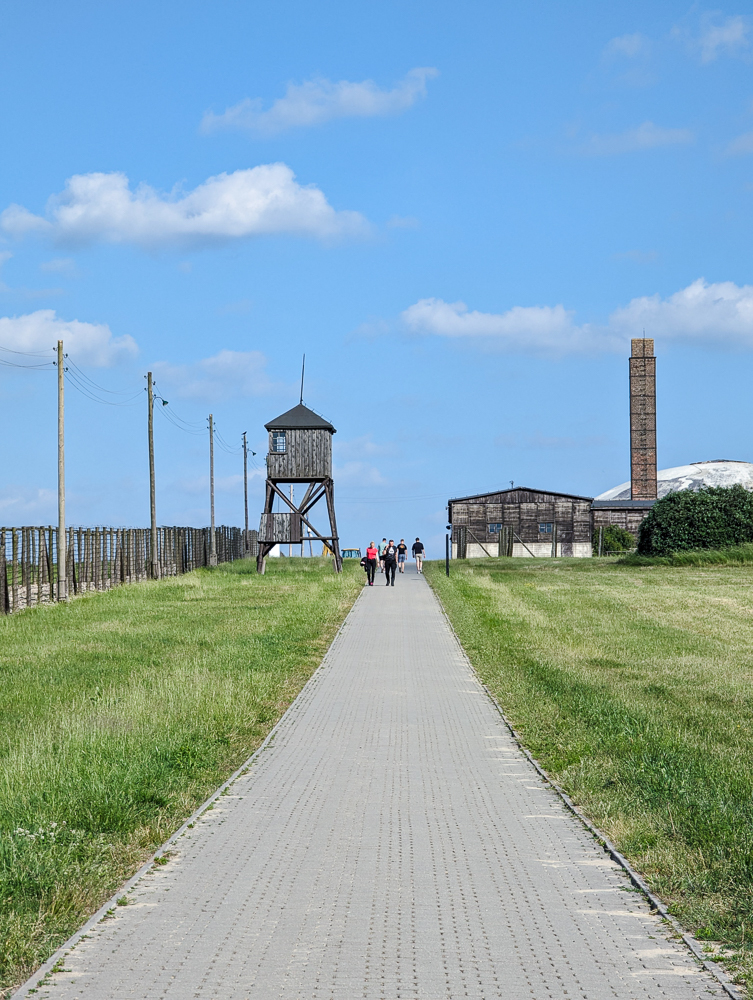
What you can see at Majdanek concentration camp
Visiting Majdanek, you’ll be able to visit the museum’s permanent exhibition and explore many of the original historical buildings throughout the former camp, many of which contain smaller exhibits themselves. You’ll also be able to see the large monument, the Mausoleum, and several smaller memorials.
Majdanek State Museum exhibits
Throughout the former camp at Majdanek you’ll find several museum-style exhibitions. The main one is inside Barracks No. 62. This is the “Prisoners of Majdanek” exhibition that focuses on the memories and experiences of those imprisoned here. Some other exhibits to see are:
- “Majdanek. Past and Present” in Barracks No. 43 which compares archival and contemporary photos of the camp
- “Lublin during the German occupation” in Barracks No. 44
- “Shrine” in Barracks No. 47 – A multimedia art installation and tribute to the camp’s victims
- Collection of shoes taken from Majdanek prisoners and Jews murdered as part of Operation Reinhard in Barracks No. 52
- “They Arrived at the Ghetto… They Left for the Unknown…” in Barracks No. 55 – All about Operation Reinhard’s mass murder
- “Living Conditions” in Barracks No. 14 and 15 – Recreations of the prisoner barracks at the time of liberation
Museum exhibits and informative panels here are in both Polish and English.
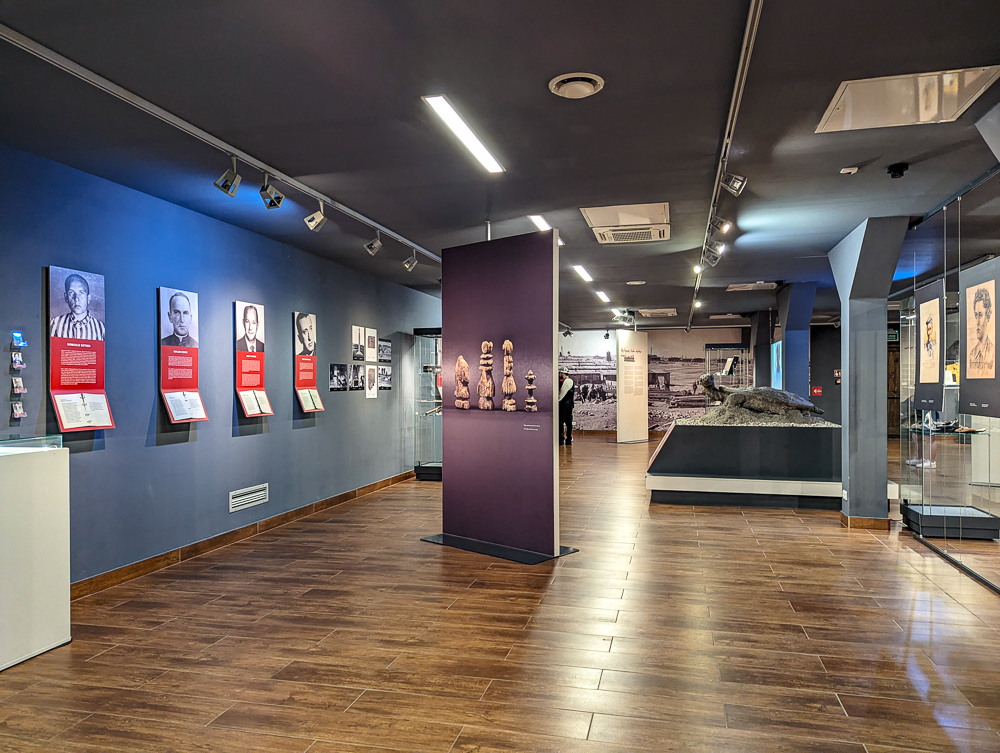
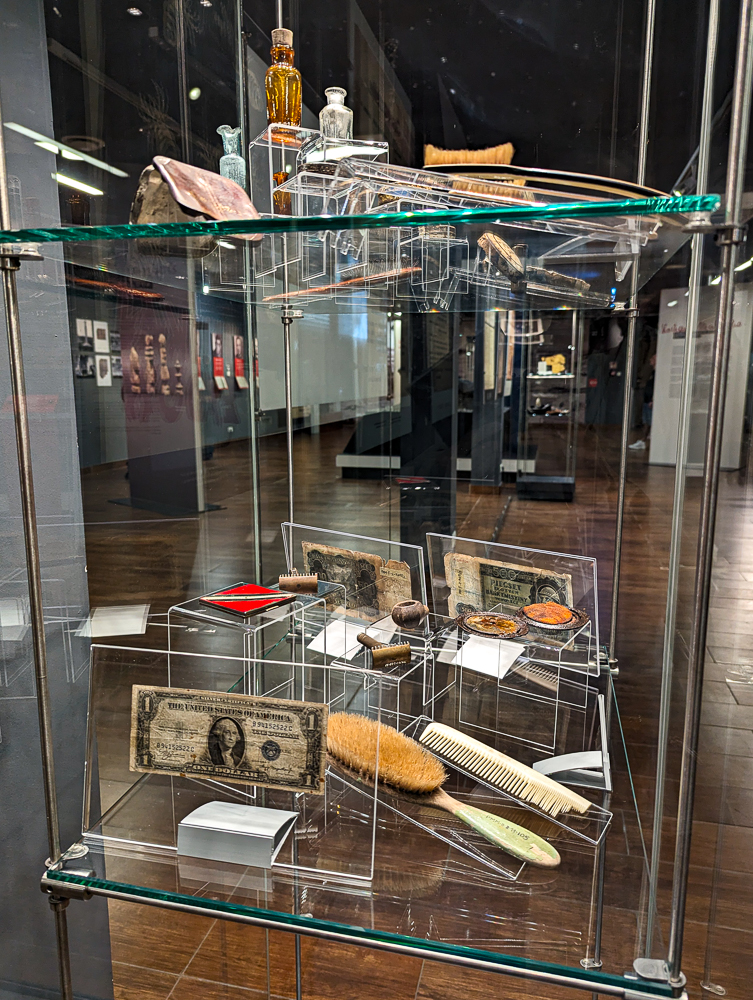
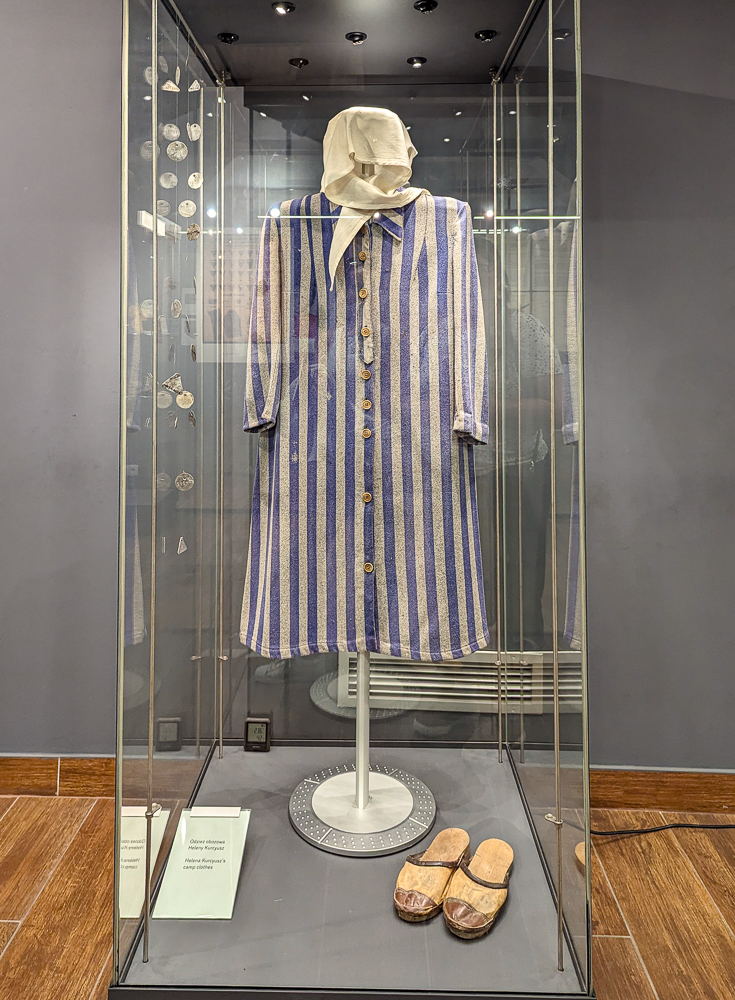
Mausoleum
Located at the far back of the camp, behind the crematorium, stands the Mausoleum. This UFO-shaped building actually resembles an old Slavic urn. Inside, it contains a large mound, created in 1947, from 15 heaps of victims’ ashes found on the property. On the outside of the structure, you’ll see the words: “Let our fate be a warning to you.”
Monument to Struggle and Martyrdom
At the front of the camp next to the main road, you’ll find the massive Monument to Struggle and Martyrdom. It is meant to resemble the Gate of Hell—symbolizing life and freedom on the outside, and the world of the dead (martyrdom) on the other.
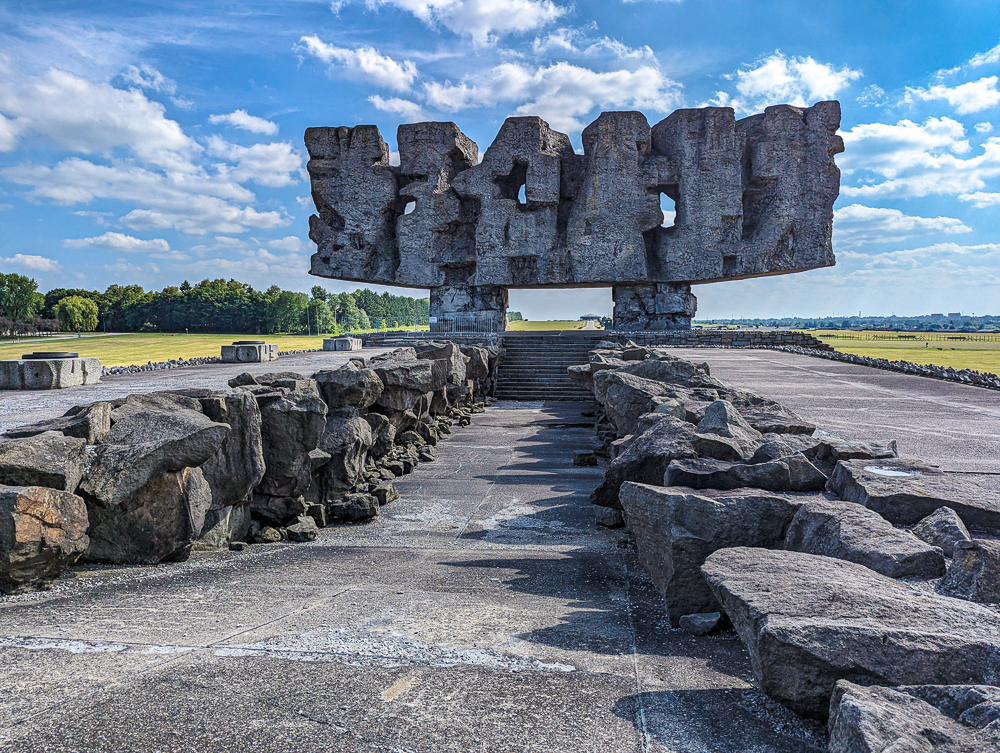
The former camp property
In between all these things are the remains of the Majdanek concentration camp. In total, you can still find 70 well-preserved original historical buildings here. You’ll be able to see prisoner barracks, the crematorium, watchtowers, the gas chamber, bathhouses, and more.
All throughout the property, you’ll also find informative signage describing many of the different areas around the former camp. You can also pick up a helpful booklet at the visitor center which describes all the sites along the recommended walking route you can follow through the site.
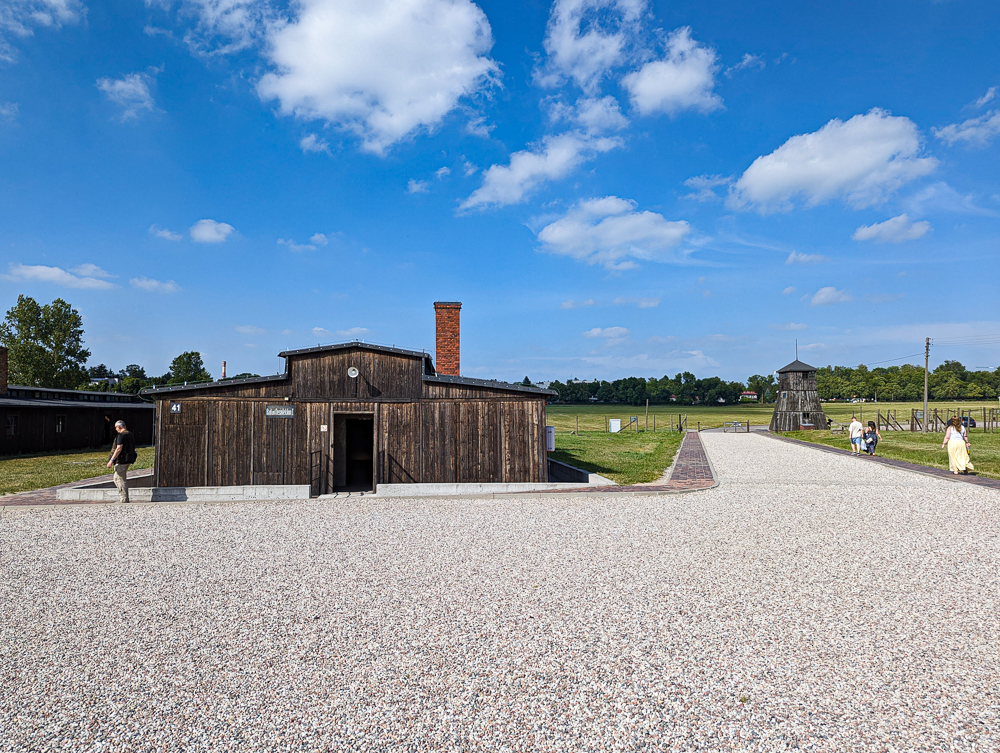
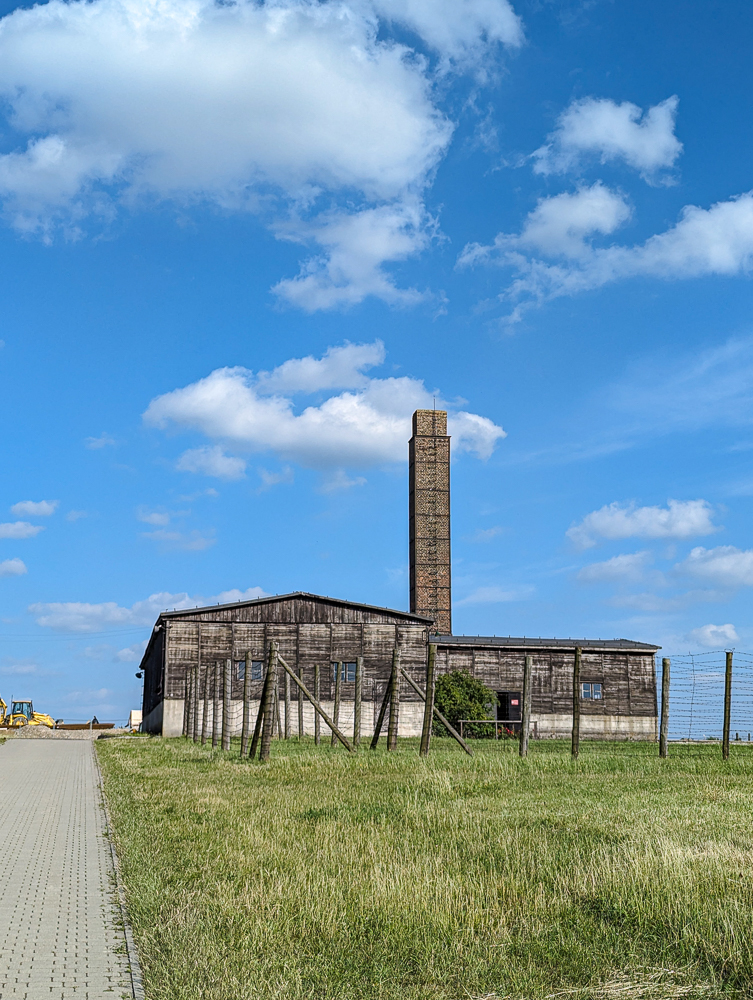
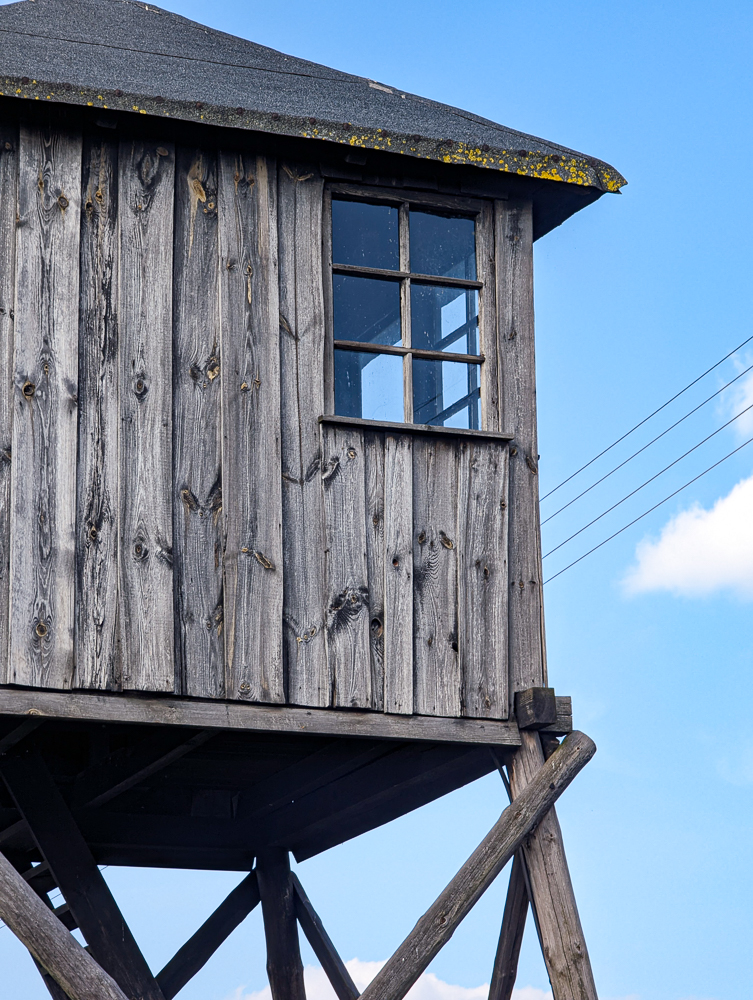
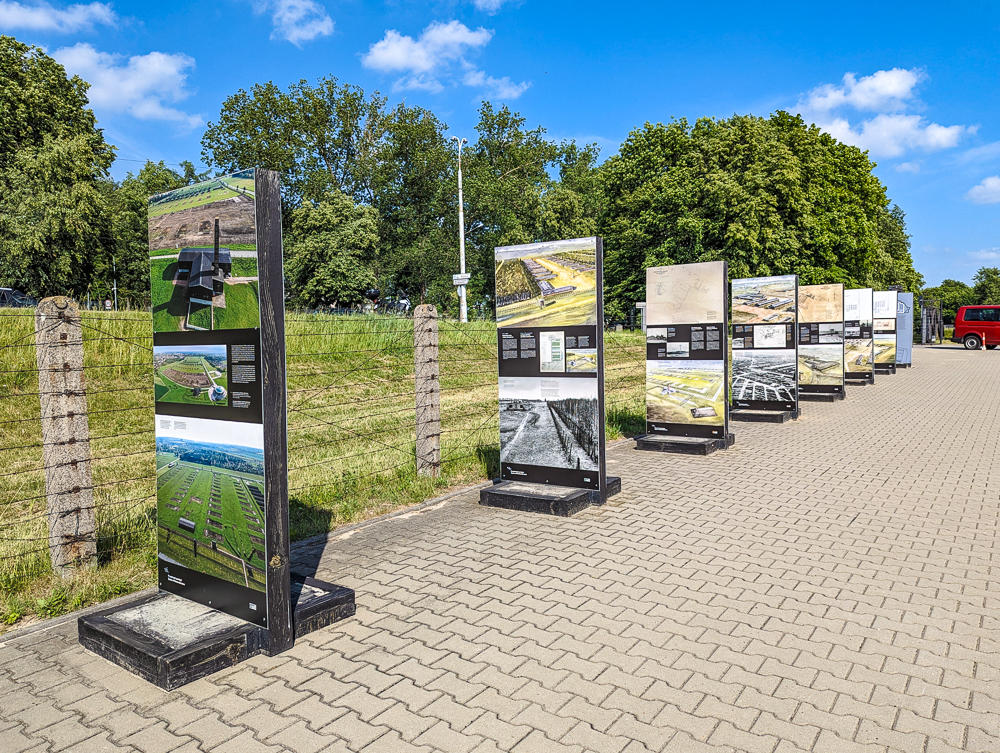
Visiting Majdanek: What to expect
After parking, make your way over to the Visitor Center at the main entrance. In here, you can check in and find some books and other information on the former camp, including the small booklet that covers the site’s historical buildings. (Available for a very small fee but definitely worth it.)
From here, you’ll pass by the large Monument to Struggle and Martyrdom and then head into the former camp. Follow the recommended walking route and you’ll pass by all the notable buildings and historical exhibitions I’ve mentioned in this post.
Your visit to Majdanek will be completely self-guided (unless you’ve otherwise arranged for a guided tour). This is contrary to somewhere like Auschwitz where your visit will almost always be fully guided. But, there is helpful and informative signage everywhere and the booklet you can purchase at the beginning tells you everything else you need to find your way around.
You’re free to spend as long as you wish visiting Majdanek, as long as the property is still open. And you’ll probably need longer than you think because this place is huge.
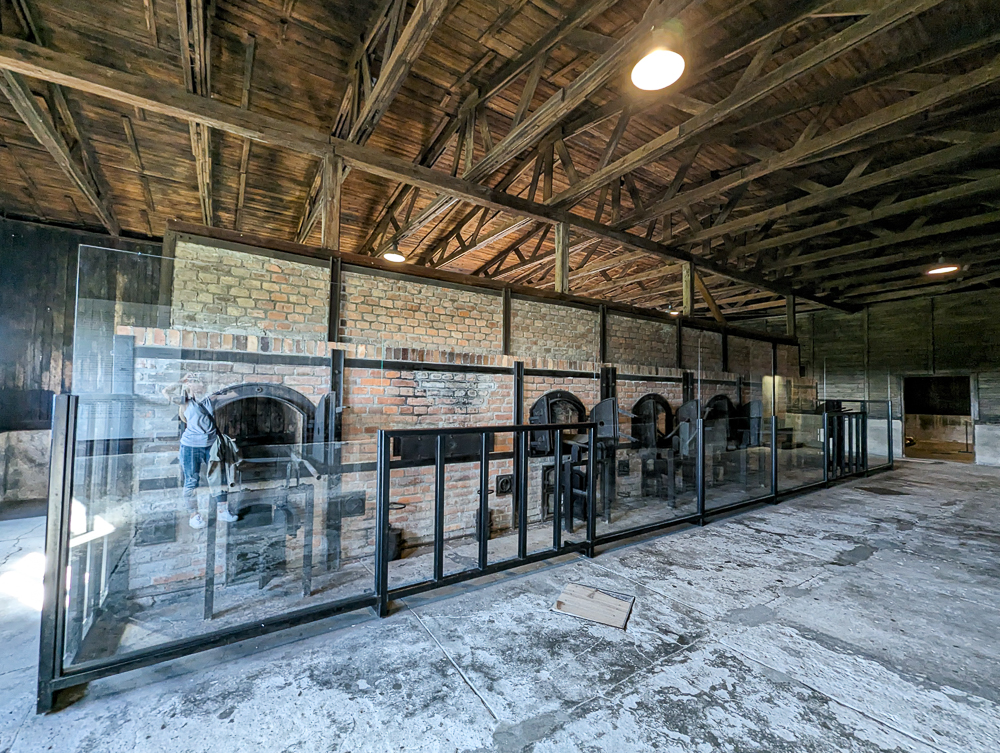
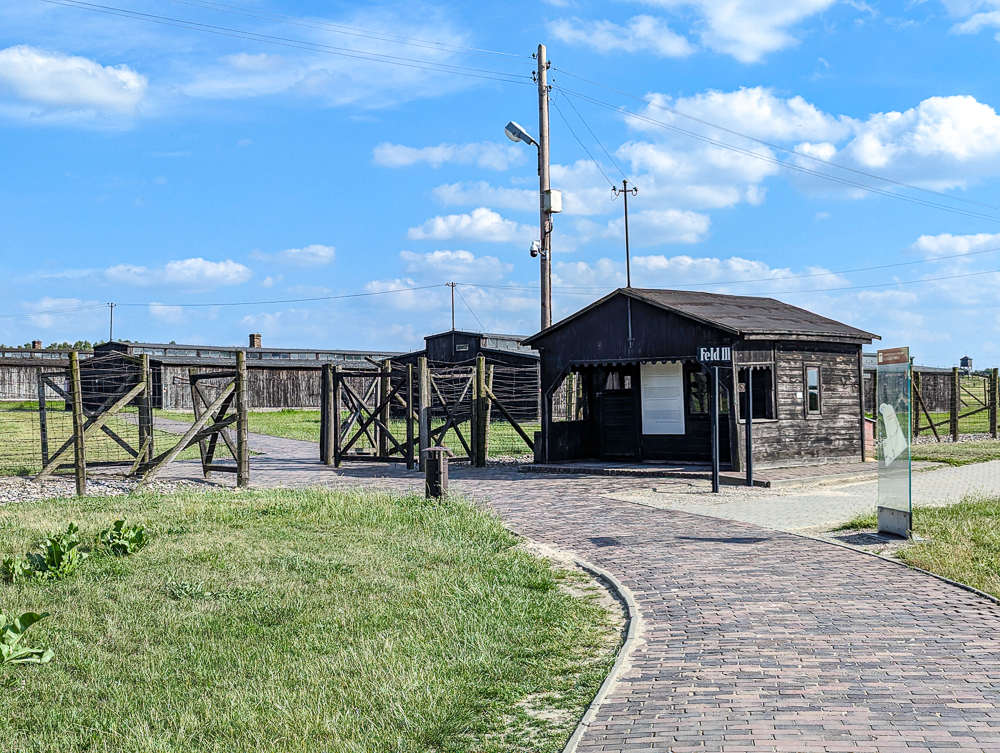
What you need to know for visiting Majdanek
Here are a few of the most important things you need to know for visiting Majdanek:
Prepare for a lot of walking
Again, this place is huge. Visiting Majdanek will require a lot more walking than you probably anticipated. For example, just from the Visitor Center to the museum exhibition in Barracks 62 is a 15-minute walk. From here to the crematorium is another 20 minutes. Then you have to walk back.
Be sure to wear comfortable, outdoor-appropriate shoes when visiting Majdanek as you’ll be walking on pavement, gravel, wood, concrete, and brick pathways. And, if you visit in the summer, be sure to also bring a bottle of water and sunscreen because this site is fully exposed to the sun. And don’t forget your walking poles if you use them.
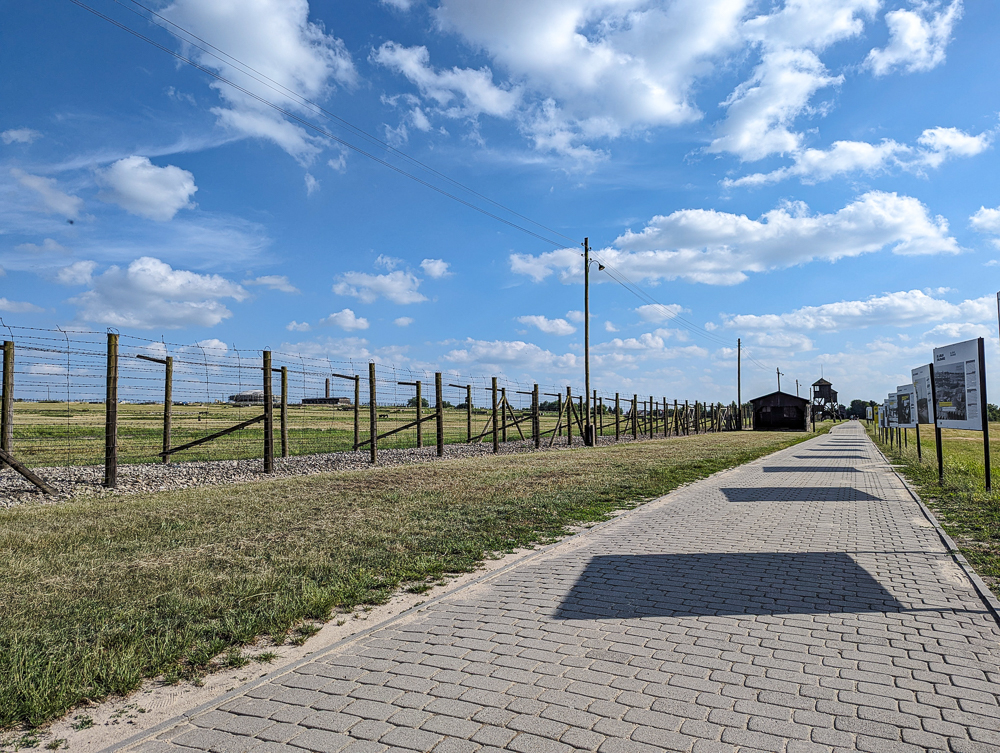
Accessibility
Due to the historical nature of the buildings here, only some parts of the former Majdanek camp are fully accessible. Please see this page for a detailed explanation or this page for more on the camp’s architectural barriers (with photos).
A few additional things to know:
- Majdanek does not recommend visits by children under the age of 14.
- Guided tours are available by reservation; more info here.
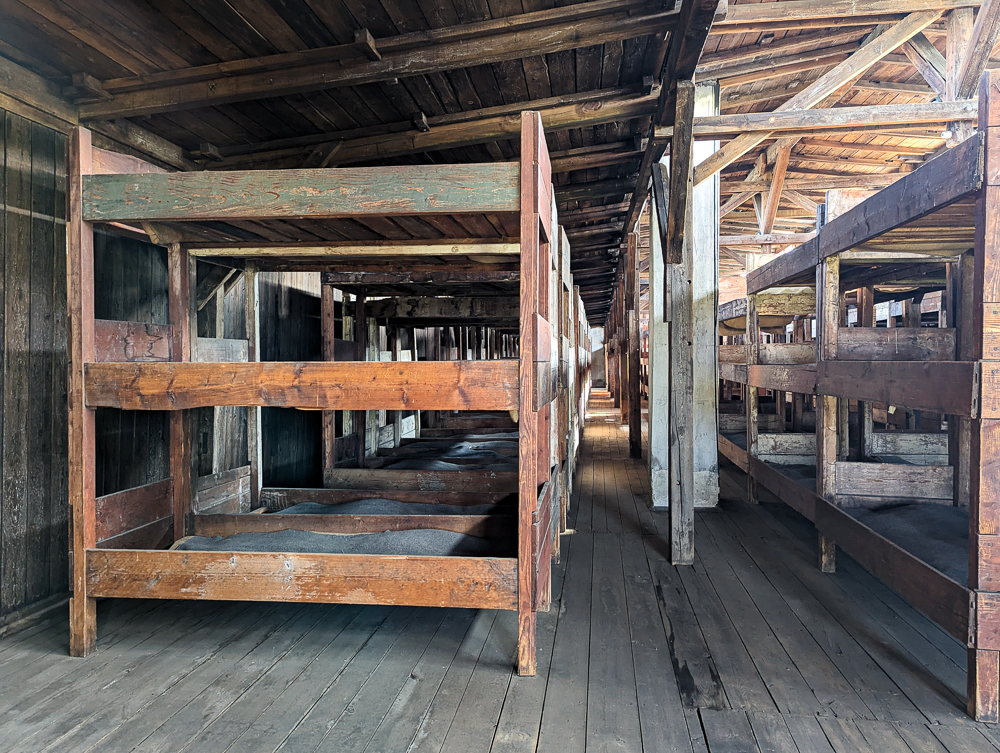
How to act at Majdanek
Hopefully you won’t see any inappropriate behavior while visiting Majdanek like I’ve seen at many camps and historical sites. Even so, here are a few simple rules to follow yourself while here:
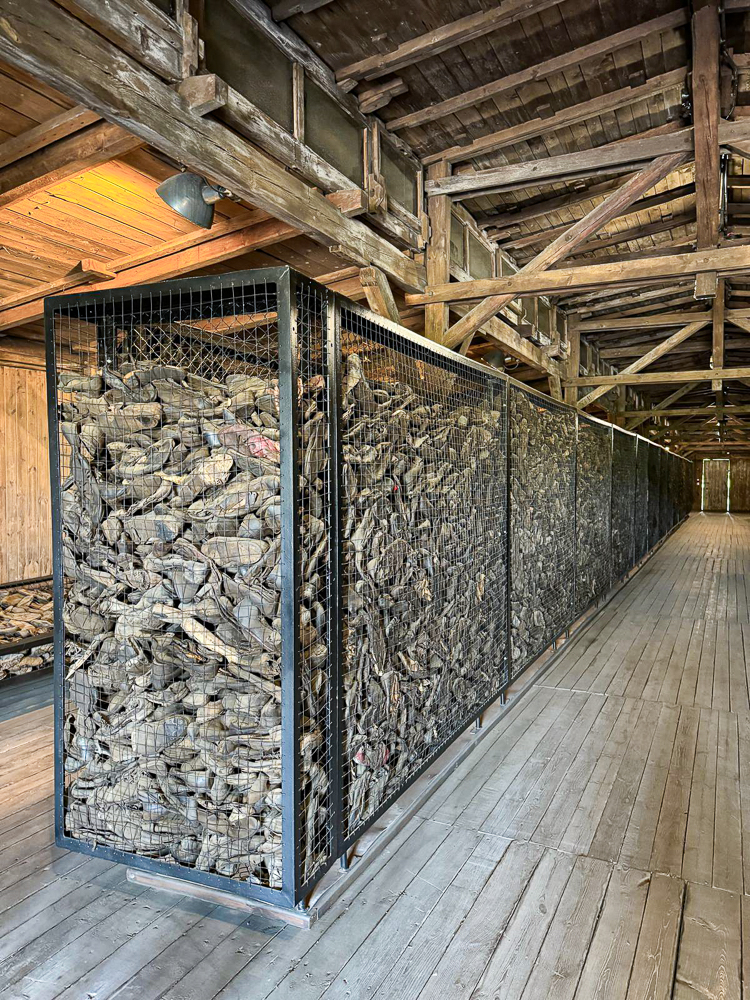
Visiting Majdanek: Essential information
Here’s all the necessary visitor information you need to plan your trip to Majdanek (accurate as of February 2025):
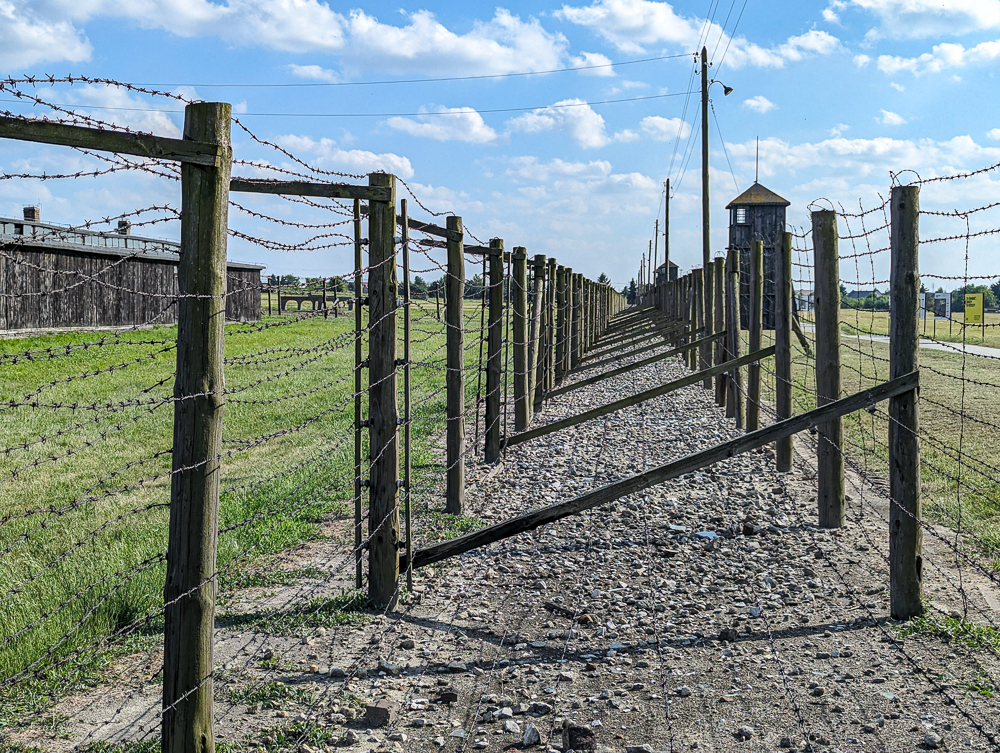
Suggested books for visiting Majdanek
Here are a few great books you can read to prepare for visiting Majdanek:
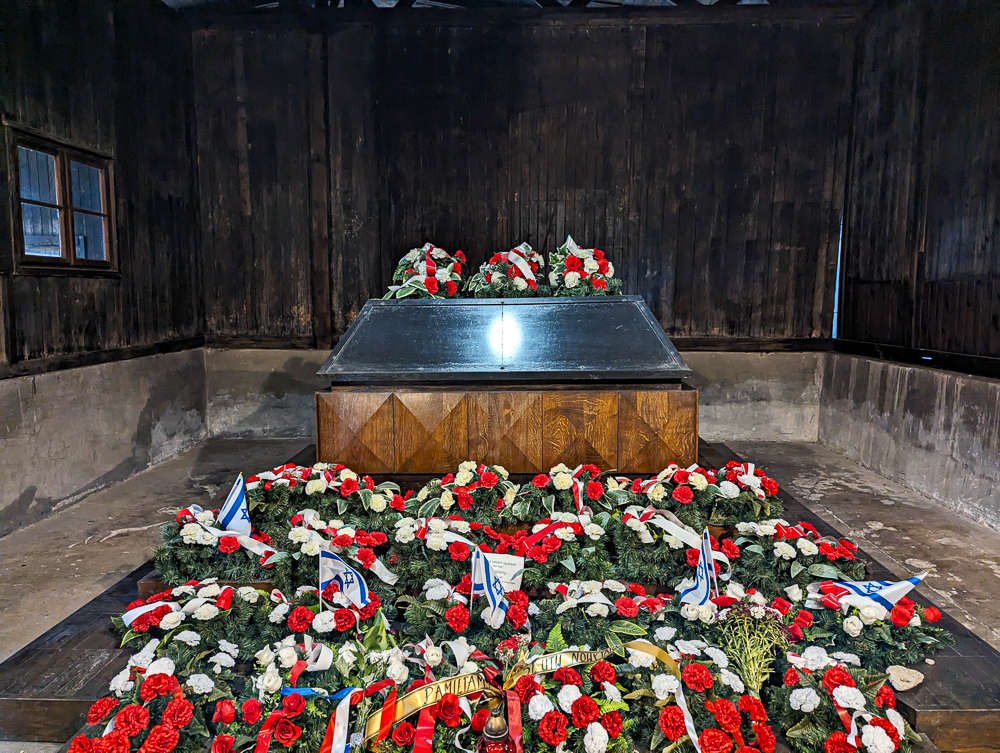
Suggested movies for visiting Majdanek
Here are a few great movies you can watch to prepare for visiting Majdanek:
For more great books to read and movies to watch before visiting Poland, see my full list in that link.
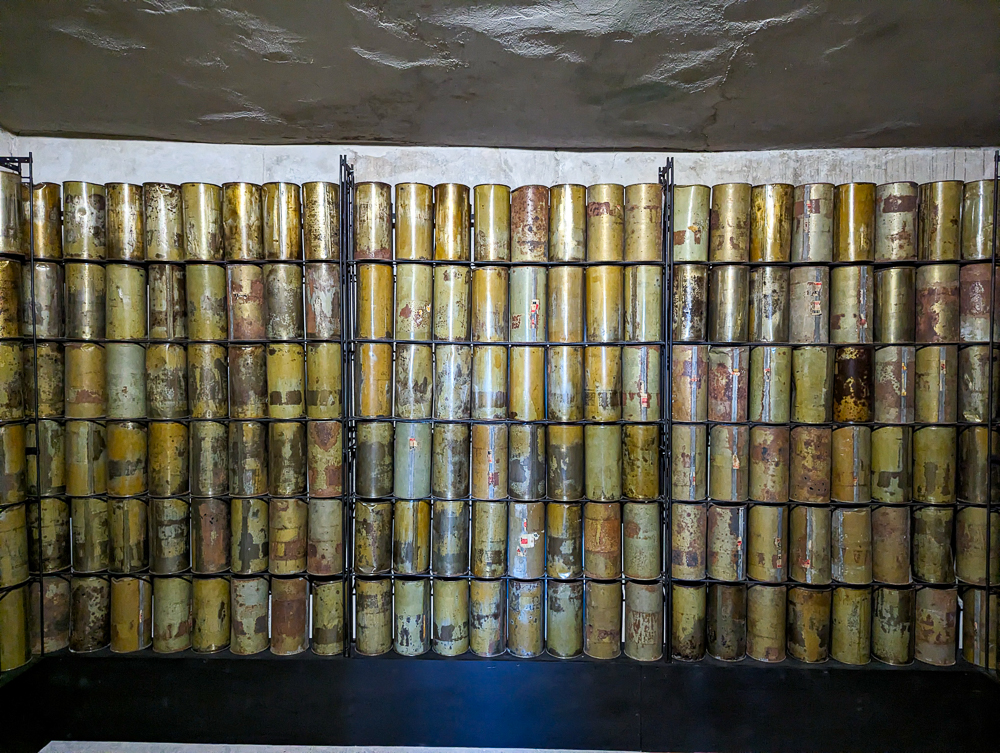
Where to eat near Majdanek
Majdanek is close to the city of Lublin, a large city with plenty of places to eat either before or after your visit to the former concentration camp. But there is one place nearby I think you might enjoy.
Before our visit to Majdanek, my friend and I had a late lunch at the Ansaldo Restaurant at the Lubhotel, which is located on the site of a former airfield. On June 19, 1921, an “Ansaldo A.1 Balilla” airplane took off from here. It was the first plane manufactured in Poland at the Plage and Laśkiewicz Mechanical Plant.
This restaurant full pays homage to Lublin’s aviation history and the interwar period. You’ll find interesting historical info and historical photos all around the restaurant. Plus, the service is friendly, the food is great, and they have their own parking lot. Ansaldo Restaurant is just a 7-minute drive from Majdanek.
Be aware that the historical theme also rolls over onto the menu which boasts entrees like fried brain and other popular foods from the 1920s. I do love the commitment to the theme though. (I had a burger.)

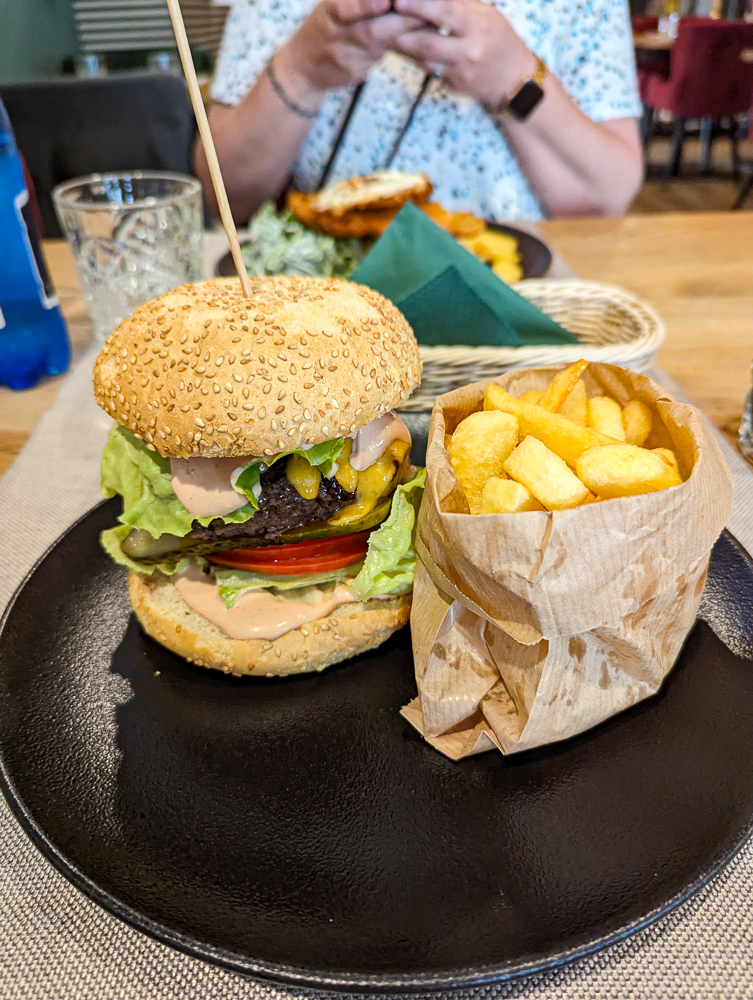
A former subcamp
Plage and Laśkiewicz operated from 1921 until 1939, after which a subcamp of Majdanek opened at the former airfield (where this restaurant is now).
Flugplatz, as it was known, served as a labor camp and sorting facility for the personal belongings of those killed at Belzec, Sobibór, and Treblinka. Flugplatz’s prisoners were eventually killed at Majdanek on November 3, 1943. A short walk from the restaurant will take you to one of the factory’s original buildings (at Wronska Street 2) where you can find two plaques commemorating this history.
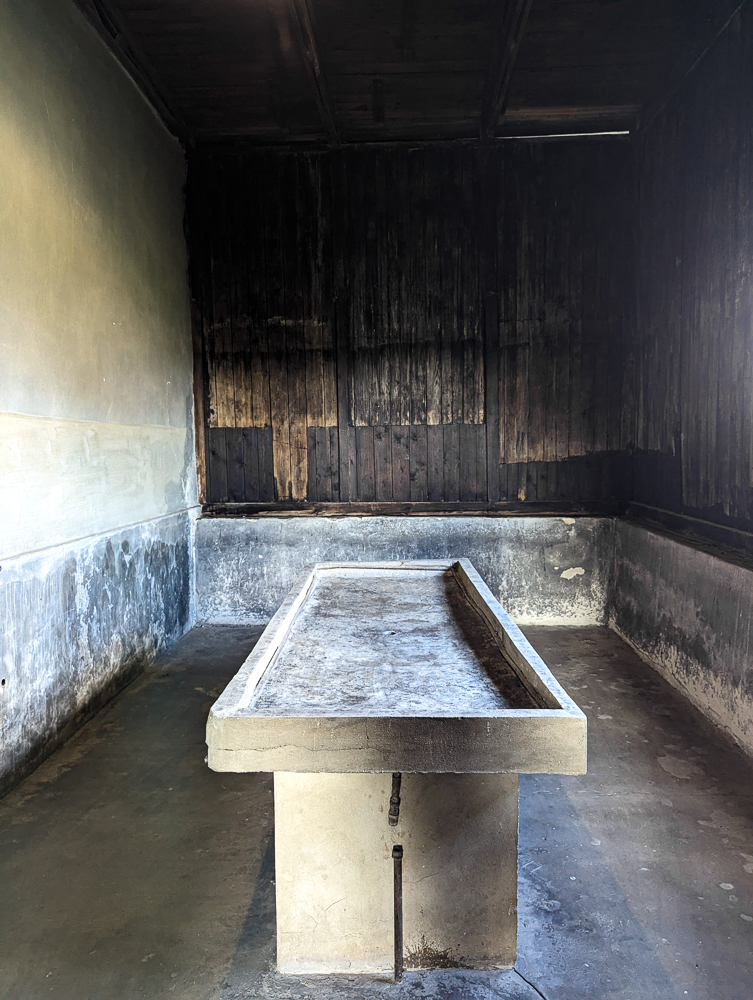
Where to stay in Lublin
For your visit to Majdanek, here are a few suggestions on where to begin your hotel search in Lublin:
There are plenty more to choose from though. See all Lublin hotel options here.
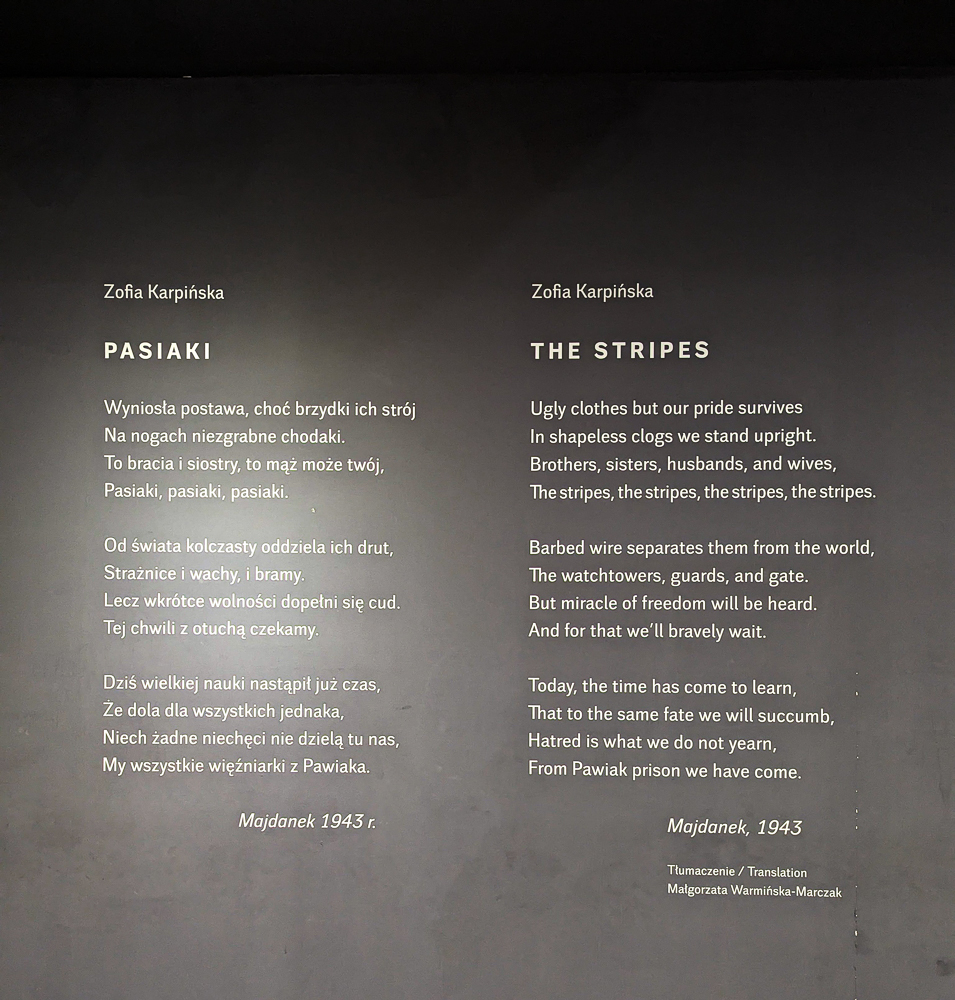
More info for your visit to Poland
- Hotels: Find great places to stay on Booking.com (my go-to). Expedia and Hotels.com are worth checking too. VRBO is best for apartment rentals.
- Rental cars: Check out the best local rental car deals here.
- For more local tours, check out all the options from Viator and Get Your Guide.
- Don’t forget a Poland guidebook and this must-have Poland customs and culture guide!
- Want more? See all my Poland posts here.
Like this post? Have questions about visiting Majdanek? Let me know in the comments below. Thanks for reading.

Save this info, pin this image:
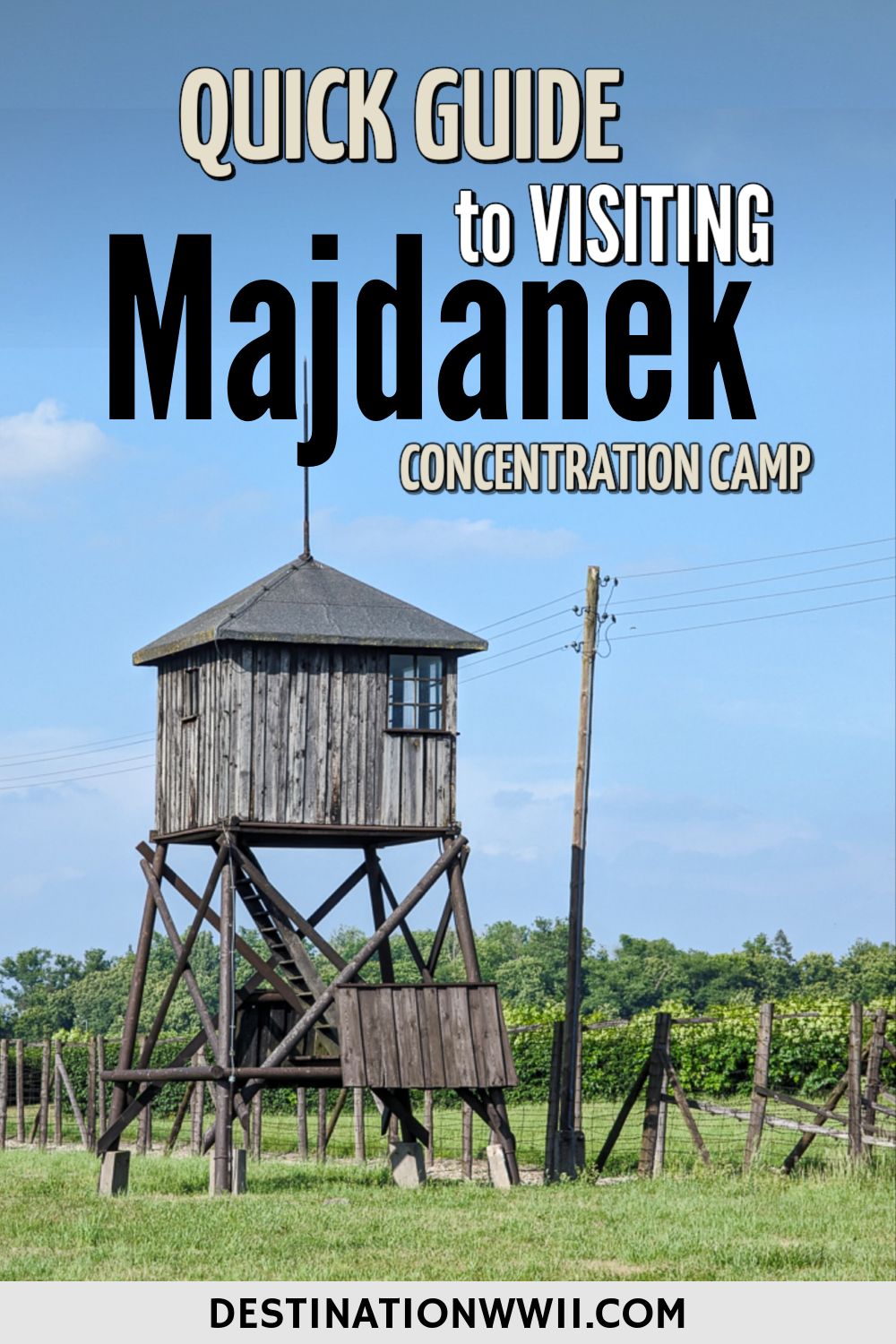

Hi Ashley! You are a woman after my own heart! I love WWII history and US Civil War history as well. I left you a brief message on the Instagram account. I’m planning a “bucket list” trip to visit Auschwitz, Majdanek, Sobibor and Belzec at the end of June. Starting with Auschwitz and taking a 6 hour study tour there. I plan to rent a car and leave early in the morning to drive to Lublin and take in Majdanek, staying close at the Lubhotel and taking your recommendation to eat at the restaurant there. Then early the next morning, driving to Sobibor and then to Belzec. What can you tell me about driving in Poland? I’ve enjoyed reading all your pieces regarding the camps and have read many books and documentaries and movies. All your information is very helpful! Hope to hear back from you about driving in Poland! Thanks! Kraig Tatro
Hi Kraig, that’s going to be an awesome trip! (Depressing of course, but definitely worthwhile.) The 6-hour study tour at Auschwitz is going to be amazing, I’m sure.
I’m actually working on a post all about driving in Poland as we speak! Let me finish this up and I’ll let you know when it’s posted.